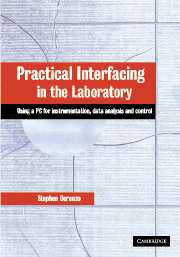Book contents
- Frontmatter
- Contents
- Preface
- Acknowledgments
- 1 Digital tools
- 2 Analog tools
- 3 Analog ↔ digital conversion and sampling
- 4 Sensors and actuators
- 5 Data analysis and control
- Appendix A Grounding and shielding
- Appendix B Experimental uncertainties
- Appendix C C programming tips
- Appendix D Numerical methods and C functions
- Appendix E Summary of Data Translation DT3010 PCI plug-in card
- Appendix F Using the digital oscilloscope to record waveforms
- Appendix G Electrical hazards and safety
- Appendix H Standard resistor and capacitor values
- Appendix I ASCII character set codes
- Glossary
- Index
Appendix H - Standard resistor and capacitor values
Published online by Cambridge University Press: 04 August 2010
- Frontmatter
- Contents
- Preface
- Acknowledgments
- 1 Digital tools
- 2 Analog tools
- 3 Analog ↔ digital conversion and sampling
- 4 Sensors and actuators
- 5 Data analysis and control
- Appendix A Grounding and shielding
- Appendix B Experimental uncertainties
- Appendix C C programming tips
- Appendix D Numerical methods and C functions
- Appendix E Summary of Data Translation DT3010 PCI plug-in card
- Appendix F Using the digital oscilloscope to record waveforms
- Appendix G Electrical hazards and safety
- Appendix H Standard resistor and capacitor values
- Appendix I ASCII character set codes
- Glossary
- Index
Summary
Standard resistor values and color codes
Carbon resistors are the most frequently used in printed circuits and come in a limited selection of values. The tables below list those values that resistor manufacturers commonly provide. In this book, all circuits used in the laboratory exercises specify resistor values taken from this list.
For carbon resistors with tolerances of 2% or larger, the first three colors are used to determine the value of the resistor. The first two colors (Table H.1) indicate the first two digits and the third color (Table H.2) indicates a multiplier. The fourth color (Table H.3) indicates the resistor tolerance. Values of commonly available 2, 5, and 10% resistors and their first three color codes are listed in Table H.4.
For metal film resistors with tolerances of 1% or smaller, the first four colors are used to determine the value of the resistor. The first three colors indicate the first three digits and the fourth color indicates a multiplier. The fifth color indicates the resistor tolerance.
Silver is used to indicate a multiplier of 0.01. For resistor values below 10 ω, the values corresponding to 11, 13, 16, 20, 24, and 30 are not available.
Tolerances of 1% or better are available in metal film resistors.
Standard capacitor values and codes
Capacitors are manufactured in a number of types and are available in a limited selection of values. The tables below list values that capacitor manufacturers commonly provide.
- Type
- Chapter
- Information
- Practical Interfacing in the LaboratoryUsing a PC for Instrumentation, Data Analysis and Control, pp. 566 - 568Publisher: Cambridge University PressPrint publication year: 2003



